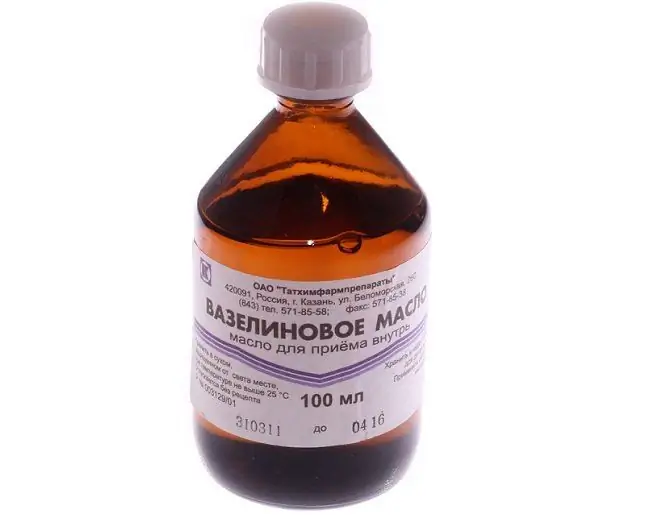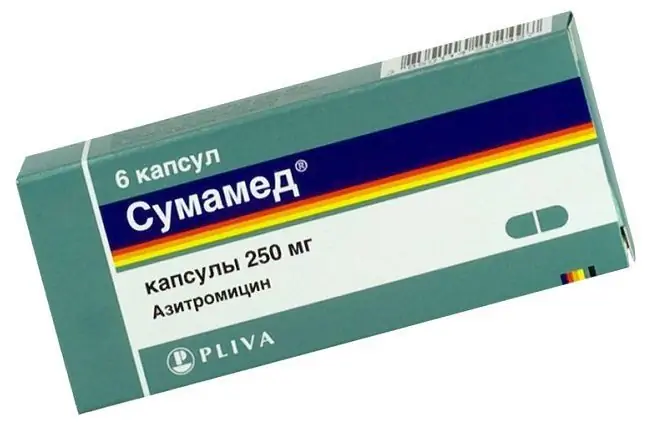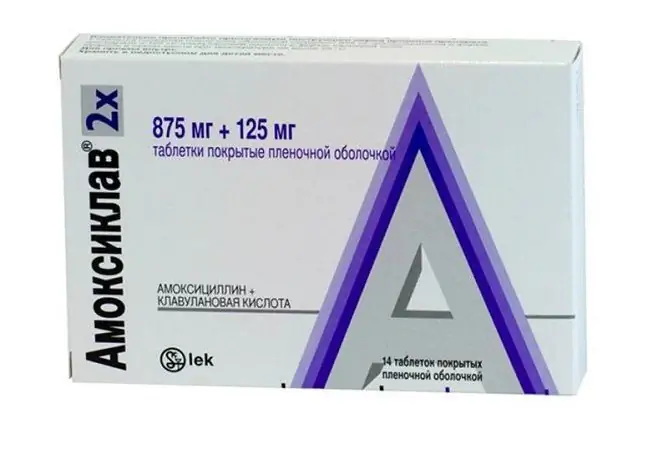- Author Rachel Wainwright [email protected].
- Public 2023-12-15 07:39.
- Last modified 2025-11-02 20:14.
Fansidar
Instructions for use:
- 1. Composition and form of release
- 2. Pharmacological action
- 3. Indications for use
- 4. Contraindications
- 5.instructions for use
- 6. Side effects
- 7. Drug interactions
- 8. Overdose
Fansidar is a combined antimalarial drug.
Delagil is an analogue of Fansidar according to the principle of action.
Composition and form of release of Fansidar
Fansidar is available in the following dosage forms:
- in the form of tablets;
- in the form of a solution for intramuscular administration.
One tablet or one ampoule (2.5 ml) of the drug solution contains 500 mg of sulfadoxine and 25 mg of pyrimethamine. The composition of the tablets of the drug includes the following auxiliary components: gelatin, lactose, corn starch, talc, magnesium stearate.
Pharmacological action of Fansidar
According to the instructions, Fansidar has an antiprotozoal, antimalarial effect. The active components of the drug are active against asexual intraerythrocytic forms of malarial plasmodia (trophozoids, schizonts). The combined action of sulfadoxine and pyrimethamine inhibits the activity of two important enzymes that affect the biosynthesis of folinic acid in microorganisms. Parasites die after a single injection of Fansidar.
This medication is active against most human pathogenic strains of plasmodia - P. vivax, P. Malariae, P. falciparum, P. ovale, including against strains resistant to pyrimethamine and to known derivatives of 4-aminoquinoline.
However, in South America, in Central and Eastern Africa, as well as in Southeast Asia, P. falciparum strains with developed resistance to the active ingredients of the drug Fansidar have been identified.
The drug is also effective in infectious diseases caused by Pneumocystis carinii and Toxoplasma gondii.
Indications for use of Fansidar
The following indications for the use of Fansidar are distinguished:
- treatment of toxoplasmosis;
- prevention of pneumocystis infection;
- treatment and prevention of malaria.
Contraindications
- hypersensitivity to sulfonamides;
- infancy up to two months;
- renal and / or hepatic impairment;
- damage to the liver parenchyma;
- oppression of bone marrow hematopoiesis;
- blood diseases;
- first trimester of pregnancy;
- lactation period.
The damaging effect of pyrimethamine on the fetus in early pregnancy has been proven, which is neutralized with the simultaneous administration of Fansidar and folinic acid.
Fansidar: instructions for use
According to the instructions, Fansidar in the form of tablets is recommended to be taken after meals with a significant amount of water (do not chew). The solution for intramuscular injection is injected deeply.
Together with Fansidar, according to the instructions, it is recommended to take quinine for about a week (to reduce the risk of relapse).

For the treatment of malaria (uncomplicated form) the following single doses of Fansidar are used:
- adults are prescribed 3 tablets or 7.5 ml of solution for injection;
- children from 10 to 14 years old - 2 tablets or 5 ml of solution;
- children from 7 to 9 years old - 1.5 tablets or 3.5 ml;
- children from 4 to 6 years old - one tablet or 2.5 ml of solution;
- children under 4 years old - 0.5 tablets or 1.5 ml of solution.
For the prevention and maintenance treatment of malaria, patients with partial immunity are recommended to take 2-3 tablets of Fansidar once every four weeks, and for patients without immunity - 1 tablet of the drug once a week. Children from 9 to 14 years old - 2 tablets, children from 4 to 8 years old - one tablet, children under 4 years old - 0.5 tablets. For children with partial immunity, the recommended dose should be taken once every four weeks, and for children without immunity, once every two weeks.
According to the instructions, Fansidar begins to be taken a week before leaving for an endemic area, and continues to take the drug throughout the entire stay, as well as in the first six weeks after returning.
For the treatment of toxoplasmosis, patients are recommended to take 2 tablets of the drug once a week for one to two months.
For the prevention of pneumonia, infants, as well as young children, are prescribed 40 mg per 1 kg of body weight (in terms of sulfadoxine content) every two weeks, for adults - one or two tablets per week.
Side effect of Fansidar
The recommended doses of Fansidar according to the instructions are usually well tolerated.
Like other medicines containing pyrimethamine or sulfonamides, Fansidar can cause the following side effects:
- Skin reactions: itching, rash, hair loss. In rare cases - Lyell's syndrome, Stevens-Johnson syndrome;
- Reactions from the digestive tract: stomatitis, a feeling of fullness in the stomach, lethargy, nausea, vomiting, hepatitis (in some cases);
- Hematological disorders - leukopenia (usually asymptomatic), anemia, thrombocytopenia, rarely agranulocytosis. In these cases, folinic acid is administered intramuscularly;
- Others: sometimes - headache, weakness, rarely - pulmonary infiltrates, cough.
Drug interactions
The simultaneous use of Fansidar and Trimethoprim increases the metabolic disorder of folic acid, which can lead to the occurrence of hematological changes.
The simultaneous administration of Chloroquine and Fansidar can contribute to an increase in the frequency and severity of adverse reactions in comparison with monotherapy with the drug.
Overdose
Symptoms: seizures, loss of appetite, nausea, signs of agitation, vomiting. If seizures occur, the patient should immediately be given parenteral diazepam or barbiturates.
Information about the drug is generalized, provided for informational purposes only and does not replace the official instructions. Self-medication is hazardous to health!






